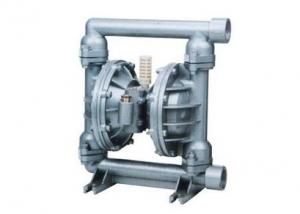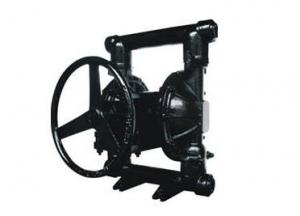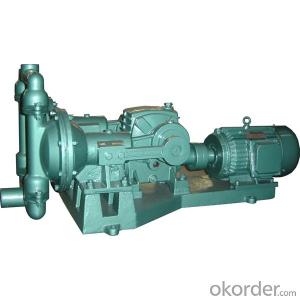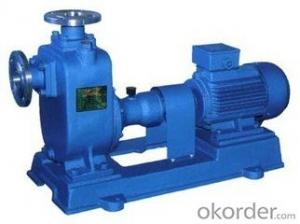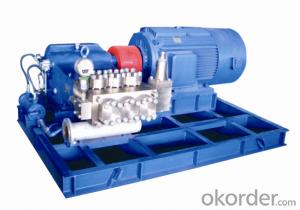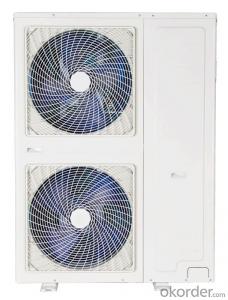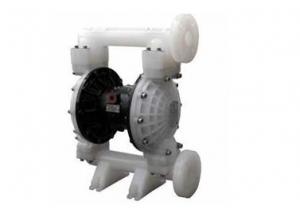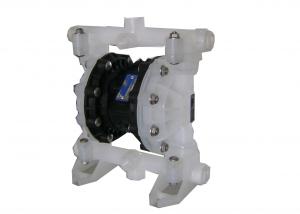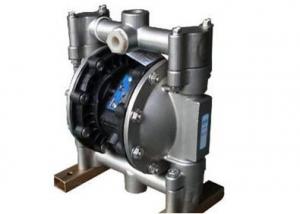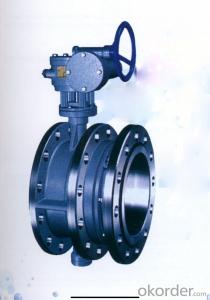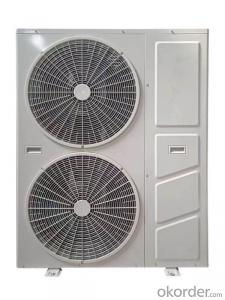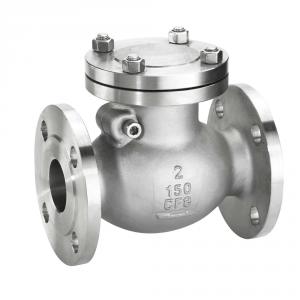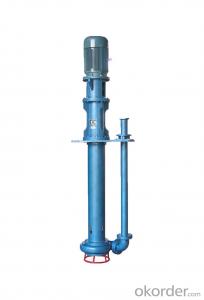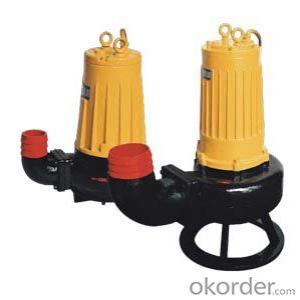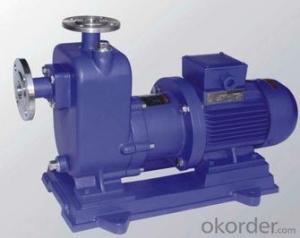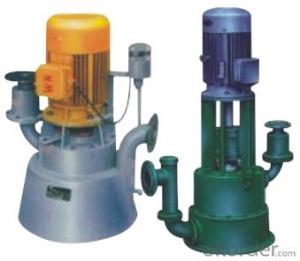Powder Diaphragm Pump
- Loading Port:
- China Main Port
- Payment Terms:
- TT or LC
- Min Order Qty:
- -
- Supply Capability:
- 1000 Per Month unit/month
OKorder Service Pledge
OKorder Financial Service
You Might Also Like
Details for Powder Diaphram Pump
1, Package and delivery of Powder Diaphram Pump
1) Packed with standard exporting wooden case, requested package will be acceptable.
2) Delivery date will be within 30 days after receiving the prepayment.
2, Technical specification of Powder Diaphram Pump
1) Connector type:2”.3”
2) Casing material:Aluminum alloy and stainless steel.
3) Max pressure psi(bar):100(6.9).
4) Max diameter of Suspended solid in(mm): 1/4" (6.4) PP20A; 3/8" (9.5) PP30A.
3, The advantages about our Powder Diaphram Pump
1) Four bolts connection with very round ball, well seal and good dry suction. The actual dry suction can reach to 4~7m.
2) High roundness valve ball for use the ball mill machine.
3) Three section manifold, Flexible installation and even can simultaneously convey two different liquids.
4) Longer diaphragm life. Diaphragm material from Dopont, Exxon.
5) Pilot type air valve, low maintenance, low air consumption, so the using cost is low.
6) Wetted body: PPH, PVDF, SS304, SS316, Aluminum etc.
7) Diaphragm: PTFE, Hytrel, Santoprene, Viton etc.
- Q:Can an air pump be used for inflating different types of objects?
- Indeed, various objects can be inflated using an air pump. Air pumps prove to be versatile instruments capable of inflating an extensive range of objects, including inflatable mattresses, sports balls, balloons, inflatable pool toys, and even certain types of tires. Typically, they are equipped with diverse nozzle attachments designed to fit the specific inflation valve of the object being inflated. Additionally, certain air pumps offer adjustable pressure settings to guarantee the proper level of inflation for different objects. Therefore, when in need of inflating a beach ball or a car tire, an air pump can serve as a convenient and efficient tool to accomplish the task at hand.
- Q:How does an air pump prevent water contamination in hydroponic systems?
- Preventing water contamination in hydroponic systems is made possible by the use of an air pump, which supplies a continuous stream of oxygen to the water reservoir. In hydroponics, plants are grown without soil, with their roots submerged in a nutrient-rich water solution. This water requires oxygen for the sustenance of plant growth and to prevent the proliferation of harmful bacteria and pathogens that can pollute the water. The functioning of the air pump involves the propulsion of air through a tube or diffuser into the water reservoir. As the air bubbles ascend to the surface, they generate agitation and movement within the water. This movement aids in enhancing the exchange of oxygen between the air and water, thereby ensuring that the water remains oxygenated. The oxygenation facilitated by the air pump plays a vital role in fostering healthy root growth and preventing waterlogging of the roots, which could result in root rot and other diseases. Furthermore, the heightened levels of oxygen create an environment that is unfavorable for the growth of detrimental bacteria and pathogens, thereby diminishing the risk of water contamination. In conclusion, the provision of necessary oxygenation to the water reservoir and prevention of water contamination are indispensable functions carried out by an air pump, thereby playing a vital role in maintaining the water quality within hydroponic systems.
- Q:What are the common maintenance tasks for an air pump?
- The common maintenance tasks for an air pump include regular cleaning and inspection, checking and replacing filters, lubricating moving parts, and ensuring proper electrical connections. Regular cleaning and inspection are important to remove any dirt, debris, or algae that may accumulate in the pump. This can be done by disconnecting the pump from the power source, removing the pump from the aquarium or pond, and using a soft brush or cloth to clean the exterior and interior components. Care should be taken to not damage any delicate parts during the cleaning process. Checking and replacing filters is crucial for the proper functioning of an air pump. Most air pumps have filters that prevent debris from entering the pump and damaging the internal mechanisms. These filters should be checked regularly and cleaned or replaced as needed. Clogged filters can reduce the airflow and put strain on the pump, leading to decreased performance or even damage. Lubricating moving parts is another essential maintenance task for an air pump. The moving parts, such as the diaphragm or piston, may require lubrication to ensure smooth operation. It is important to use a lubricant recommended by the manufacturer and apply it according to the instructions provided. Over-lubrication should be avoided as it can lead to clogging or malfunctioning of the pump. Ensuring proper electrical connections is vital for the safe and efficient operation of an air pump. Regularly inspect the power cord for any damage or fraying, and replace it if necessary. Check the electrical outlets and make sure they are properly grounded. Additionally, verify that the power supply matches the pump's requirements to prevent overheating or electrical issues. In summary, the common maintenance tasks for an air pump involve regular cleaning and inspection, checking and replacing filters, lubricating moving parts, and ensuring proper electrical connections. Following these maintenance practices will help extend the lifespan of the air pump and ensure its optimal performance.
- Q:Can an air pump be used for filling up oxygen tanks?
- No, an air pump cannot be used for filling up oxygen tanks. Air pumps are designed to compress and pump regular air, which consists of approximately 21% oxygen, along with other gases like nitrogen and trace amounts of other elements. Oxygen tanks, on the other hand, are specifically designed to store and contain pure oxygen. Pure oxygen is used for various medical purposes and needs to be stored at high pressure to ensure its availability in emergencies or for patients with respiratory conditions. Therefore, specialized equipment, such as oxygen concentrators or oxygen compressors, is necessary to fill up oxygen tanks with pure oxygen safely and efficiently.
- Q:How efficient is an air pump?
- Various factors, such as the type of pump, its design, and its intended use, can influence the efficiency of an air pump. However, in general, air pumps are renowned for their ability to convert electrical energy into compressed air with high efficiency. Take electric air pumps, for example. They are widely used and recognized for their efficiency. These pumps are engineered to minimize energy loss during the conversion process, ensuring that a significant amount of electrical energy is transformed into compressed air. This efficiency is critical as it leads to reduced energy consumption, which is advantageous both economically and environmentally. Moreover, air pumps exhibit high efficiency in terms of their performance. They can generate a substantial volume of compressed air for various purposes, such as inflating tires, powering pneumatic tools, and operating machinery. This efficiency enables air pumps to swiftly and effectively provide the required air pressure, minimizing the time and effort needed to complete a task. However, it is worth noting that the efficiency of an air pump can vary depending on its specific application. For instance, smaller air pumps designed for inflating small objects or air mattresses may have slightly lower efficiency compared to larger industrial air compressors. This is because smaller pumps may not require the same power and performance levels as their larger counterparts. In conclusion, air pumps are generally considered to be efficient devices due to their effective conversion of electrical energy into compressed air. Their high efficiency not only reduces energy consumption but also ensures optimal performance for various applications.
- Q:How does an air pump maintain a constant pressure?
- An air pump maintains a constant pressure by utilizing various mechanisms and components. One such mechanism is a pressure sensor, which constantly monitors the pressure level inside the pump. When the pressure drops below the desired level, the pump activates and starts compressing air to increase the pressure. Once the pressure reaches the desired level, the pump automatically shuts off to prevent over-pressurization. Another component that helps maintain constant pressure is a pressure relief valve. This valve is designed to open when the pressure exceeds a certain threshold, allowing excess air to escape and preventing the pressure from exceeding safe limits. This ensures that the pressure remains within the desired range, preventing damage to the pump or the system it is supplying air to. Furthermore, air pumps often have a pressure regulator, which allows the user to set and maintain a specific pressure level. The regulator adjusts the flow of air entering or leaving the pump, controlling the pressure according to the user's requirements. Overall, through the use of pressure sensors, relief valves, and regulators, an air pump can effectively maintain a constant pressure by continuously monitoring and adjusting the air flow to keep the pressure within the desired range.
- Q:How does an air pump handle different air densities?
- An air pump is designed to handle different air densities by utilizing a mechanism called compression. This mechanism involves compressing air molecules together, which increases the pressure and creates a higher density of air. When the air pump is turned on, it creates a vacuum or low-pressure zone inside the pump. This low-pressure zone allows air from the surrounding environment to be drawn into the pump. As the air enters the pump, it passes through a chamber where a piston or diaphragm compresses the air. The compression process reduces the volume of the air while simultaneously increasing its pressure. This compression is what enables the air pump to handle different air densities. Regardless of the initial density of the air being drawn into the pump, the compression mechanism ensures that the air is compressed to a higher density before being expelled from the pump. In simpler terms, the air pump essentially squeezes the air molecules closer together, which increases their density. This compression mechanism allows the air pump to handle air of varying densities, whether it is thin at high altitudes or denser at lower altitudes. It is worth noting that air pumps may have different designs and mechanisms depending on their purpose and application. However, the basic principle of compression remains the same, enabling the pump to handle different air densities effectively.
- Q:Are air pumps powered by electricity?
- Yes, air pumps are typically powered by electricity.
- Q:I bought a 10 dollar single oxygen pump today. It's plugged in. How can I use it properly? Is it going to be open day and night? Will it burn out?!
- Oxygen pumps do not open for 24 hours all day long! Usually in the morning, afternoon, each charge 2 hours or so, the evening charge for a while, if the weather is overcast, then open a longer time. If you do not have a filter, you should always change the water for the fish, preferably 3 or 4 days at a time, with 1/3 of the total water, but it must be dried! The temperature of the water should be similar to that of the fish tank! Every time you don't feed too much, clean up the excreta in the fish tank! Fish farming is very learned. Wish you success in fish farming!
- Q:What is the recommended air pressure for different types of inflatables?
- Different types of inflatables have varying recommended air pressures depending on the specific item. Here are some suggestions for common inflatables: 1. Pool floats and inflatable toys: Generally, these should be inflated to a lower air pressure, typically around 1-2 PSI. It is important to avoid over-inflating them as it can strain the seams and cause damage. 2. Air mattresses: Most air mattresses suggest an air pressure of approximately 6-8 PSI. However, it is crucial to refer to the manufacturer's instructions for specific requirements, as certain models may have different recommendations. 3. Balloons: Regular latex balloons typically require an air pressure of about 0.5 PSI. To prevent bursting, it is crucial to adhere to the recommended guidelines and avoid over-inflation. 4. Inflatable boats and kayaks: The air pressure for these inflatables may vary based on size and material. Generally, it is advisable to maintain a range of 2-3 PSI. Nonetheless, accurate guidelines should be sought from the manufacturer's instructions. 5. Gym/exercise balls: The recommended air pressure for gym or exercise balls depends on their size and intended use. In general, most exercise balls require an air pressure of approximately 4-5 PSI. However, it is important to verify the specific instructions provided by the manufacturer. Remember to consult the manufacturer's instructions for precise and specific air pressure recommendations for your particular inflatable. Over-inflation or under-inflation can affect performance, durability, and safety, so following the recommended guidelines is crucial.
1. Manufacturer Overview |
|
|---|---|
| Location | Shanghai,China |
| Year Established | 2010 |
| Annual Output Value | Below US$1 Million |
| Main Markets | 25.00% Southeast Asia 25.00% South America 20.00% Western Europe 10.00% Africa 10.00% North America 5.00% Mid East |
| Company Certifications | CE certificate |
2. Manufacturer Certificates |
|
|---|---|
| a) Certification Name | |
| Range | |
| Reference | |
| Validity Period | |
3. Manufacturer Capability |
|
|---|---|
| a)Trade Capacity | |
| Nearest Port | Shanghai port |
| Export Percentage | 61% - 70% |
| No.of Employees in Trade Department | 6-10 People |
| Language Spoken: | English, Chinese |
| b)Factory Information | |
| Factory Size: | 1,000-3,000 square meters |
| No. of Production Lines | Above 2 |
| Contract Manufacturing | OEM Service Offered |
| Product Price Range | High and/or Average |
Send your message to us
Powder Diaphragm Pump
- Loading Port:
- China Main Port
- Payment Terms:
- TT or LC
- Min Order Qty:
- -
- Supply Capability:
- 1000 Per Month unit/month
OKorder Service Pledge
OKorder Financial Service
Similar products
New products
Hot products
Related keywords
